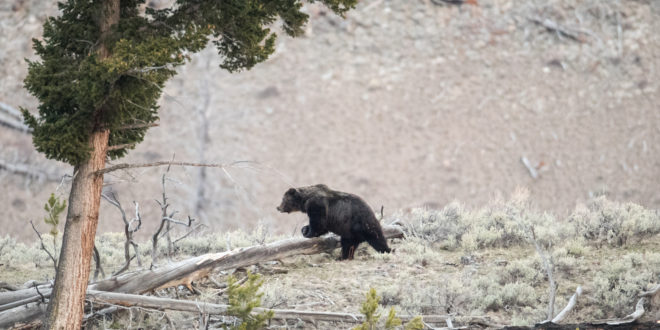At a meeting Tuesday night at the Collage of Eastern Idaho in Idaho Falls, Fish and Game officials made their case for a grizzly hunt.
The commission’s current plan is to host a season on one male grizzly. The hunt would largely take place in Fremont County, which borders Wyoming and includes the Caribou-Targhee National Forest and a slice of Yellowstone National Park. The hunt could also extend into northern Teton County. The hunter who draws the proposed Idaho tag would be banned from using dogs or bait, among other restrictions.
According to the Post Register, the plan outlined above is a draft one. A final plan is expected before the Fish and Game Commission Thursday, May 10. Officials plan to host the hunt in the fall.
We previously reported Idaho Fish and Game officials would be presenting the commission’s hunting plan April 17 and 19 in Idaho Falls and Boise, respectively.
According to the Register, presenters discussed grizzly recovery and range extension, calling both measures a success.
The U.S. Fish and Wildlife Service stripped endangered species protections from Yellowstone-area grizzly bears in June 2017. Management of the population turned over to the states of Montana, Wyoming, and Idaho in August 2017.
Looking at Idaho’s neighbors, Wyoming has proposed allowing hunters to take up to 24 grizzly bears this fall, while Montana has declined to host a hunting season this year due to ongoing litigation against the delisting.
Indeed, Idaho Fish and Game officials noted in their meeting the possibility that the commission’s proposed hunt could be blocked:
Regional Wildlife Manager Curtis Hendricks said the proposal is for the single bear to be taken in a controlled hunt that is organized along the same lines as other controlled hunts in Idaho. The tag will be issued through a lottery system rather than through an auction system, as is done for exclusive hunts in some states. The major difference, Hendricks said, is that in 2018 an application for the grizzly hunt won’t prevent applying for another controlled hunt.
There are two main reasons, he said. First, grizzly delisting plans are the subject of federal litigation, so it’s possible that the hunt could be blocked by the courts. Second, due to the late date at which the drawing will take place, many who have already applied for other controlled hunts could be excluded.
Currently, six lawsuits have been filed against the USFWS arguing the agency prematurely delisted Yellowstone area grizzly bears. Critics of the agency’s decision argue bear populations are nowhere near recovered and say a hunt would only further endanger bear populations.
The USFWS announced in December 2017 that it would review its decision following a court ruling against the agency over its handling of wolf management in the Great Lakes Region. A federal judge ruled the agency had erred in delisting these wolves because it had not considered how the delisting would impact wolf populations as a whole. Critics of delisting say the agency has made the same mistake here with Yellowstone grizzly bears.
In March, a federal judge announced an August hearing for the various grizzly suits, just ahead of Wyoming and Idaho’s proposed hunting seasons.
Grizzly bears once roamed across much of the United States west of the Mississippi and in Canada. Due to hunting and lethal wildlife control, among other factors, the population was decimated. At the time of its induction to the Endangered Species List in 1975, there were only about 136 bears in the Greater Yellowstone Ecosystem. Today, that number is closer to 690.
Critics of hunting and delisting, say the grizzly bear cannot be considered recovered until it has reestablished itself on its historic range and reconnected with other “islands” of bears. In Montana, for instance, research shows Yellowstone bears may have viable paths toward reuniting with bears in the Northern Continental Divide Ecosystem in northwestern Montana.
Critics also highlight the danger that a hunter may kill a female grizzly bear, which would detrimentally impact the bear’s long term survival. Wildlife officials say any risk can be offset by consulting with other states or counting any inadvertent female kills against future grizzly hunts. Senior Attorney Andrea Santarsiere, who works for the Center of Biological Diversity, which is one of the groups suing the USFWS, told the Register that this approach is “completely irresponsible.”
Wildlife officials like Hendricks have pushed back at this criticism. “We haven’t put this much energy into getting grizzlies delisted to do anything that would endanger that,” said Hendricks at the April 17 meeting.
In addition to the six suits noted above, another lawsuit filed against the USFWS by a coalition of Native American tribes argues the decision violates tribal sovereignty and the American Indian Religious Freedom Act.
According to the Register, Shoshone-Bannock Tribes Chairman Nathan Small said in a press release that no grizzlies will ever be hunted on Shoshone-Bannock lands and that the tribe vigorously opposes all attempts to hunt them “in our recognized ancestral homelands.” Councilman Lee Juan Tyler also spoke out against hunting in the release, saying that tribes hold the grizzly bear “to be a brother/uncle to our people,” adding that tribes like the Shoshone-Bannock have ceremonies and songs to celebrate the bear.
 Yellowstone Insider Your Complete Guide to America's First National Park
Yellowstone Insider Your Complete Guide to America's First National Park





